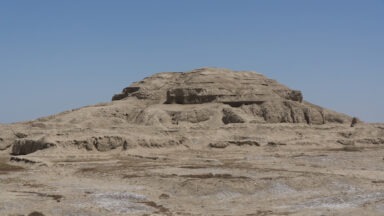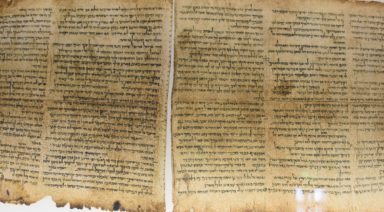Mysterious Geoglyphs in India Are Largest Ever Discovered

Researchers discovered the world’s largest geoglyphs in the Great Indian Desert. Will their findings reveal who made these giant, enigmatic designs, and why?
Geoglyphs are sprawling designs made by digging into the Earth or piling up stones to form what mostly appear as geometric lines, and more rarely, as humans and animals.
Usually only fully visible from above, they can be found all over the world with some dating back to prehistoric times, and others quite recent. The most famous to date are the Nazca lines in Peru. While there are various theories around their builders and function, none have been proven and continue to be widely debated.
Carlo Oetheimer is an independent researcher of geomorphology, the study of Earth’s landforms. While conducting a Google Earth survey of India, he and his son Yohann Oetheimer, made a fascinating discovery.
“I was traveling all over the desert, and suddenly I found lines in the desert similar to the Nazca lines. I was amazed, and I said, ‘Oh, what’s that?’ I found one place, then two places, then eight places almost. That was the way I found the Thar Desert Boha geoglyphs,” C. Oetheimer said.
“So, under Google Earth’s images, we could see a concentric spiral — concentric lines. We didn’t really know at that point what they were, but we had to go on the site, on the field, to understand them better,” Y. Oetheimer said.
When the researchers visited the desert site in India’s Rajasthan region, what they found astounded them.
“We brought a drone with us to be able to take aerial photos of the geoglyphs. With the drone images we could finally see the true form of the line, which is a spiral,” Y. Oetheimer said.
“Those glyphs are really, really big. They are the biggest geoglyphs discovered so far on Earth. It’s a big spiral which is an 11 km continuous line. The other one, which is connected to the spiral, is a serpent-shaped line with many patterns. We’ve managed to reproduce 48 km of lines. In the lines, you have archeological features which are called memorial stones. The big ones are in memory of deceased persons. For us, these landmarks are a symbol of death. We have to understand if there are connections between these Hindu memorial stones and the lines,” C. Oetheimer said.
Given the difficulty of precise archaeological dating in a desert environment, the Oetheimers are very cautious about providing any definitive interpretations of the origins and meaning of the geoglyphs. They are, however, working on some ideas.
“Concerning the antiquity of the lines, the main point, of course, is not the fact that they are at least 150 years old,” C. Oetheimer said. “We don’t know exactly, but I’m almost sure that they are not old, that’s for sure. What is interesting here is more the symbols. As the line ends with a little spiral or begins with a little spiral, we were wondering if this was a kind of global symbol of the life of a human in the Thar Desert. It’s obviously made to see from above, so we’re supposed to see a symbol of heaven, the afterlife, and the gods. With the north-south lines we were wondering if they could symbolize something with the cosmos, and suddenly we got the idea that we could try to separate both the Ursae Minoris, so the constellation of Ursa Minor, on this spiral. This gives an interpretation of how this is a message to the cosmos; to the people who are in this other world.”
The team plans to continue trying to glean further information about these fascinating designs. However, it is likely, they say, that the true origins will remain a mystery.
The Real History of Giants Living on Earth

Humans have long expressed a fascination and fear around the question, “Were there giants on Earth?” Whether in legends or life, giants have been worshipped, reviled, ostracized, and celebrated. While the existence of dinosaurs is largely accepted, and millions of people travel across continents to marvel at majestic, larger-than-life monuments, the facts about human giants or giant races are up for debate. Regardless of whether they are dismissed as a myth or accepted as fact, giants represent important aspects of our individual and collective psyche. They capture our imagination, appear in religious texts, and drive scientific inquiry. But the question still remains — did giants once roam the earth?
Proof of Giants Throughout History
The concept of giants has been a part of human folklore and mythological narratives for millennia, resonating through various cultures and continents, from the Americas to Africa and from ancient Israel to the Norse. In the Americas, both North and South have indigenous legends speaking of giant beings, some even overlapping with interpretations of megafauna like mastodons that once roamed the land. The Native American tales often include references to a race of giants, which could be considered a cultural memory of these large prehistoric animals.
In Biblical Text
The biblical references, such as those found in the Book of Genesis, speak of the Nephilim, a race of giants that existed before the Flood. These beings have been subject to much interpretation, with some considering them metaphorical while others believe in their literal existence. David’s battle against Goliath is one of the most iconic stories of a human overcoming a giant from the Bible.
Around the World
From Africa to Germany, as well as in the Norse traditions of Europe, tales of giants are common, often tied to the creation myths and early histories of peoples. Native American folklore across various tribes frequently speaks of giants, who are depicted as powerful spirits or ancestors that roamed the land, some of whom interacted with the people, teaching or challenging them. In Egyptian mythology, the giant Geb, the god of the Earth, was often depicted as a colossal figure whose laughter was believed to cause earthquakes and whose body formed the hills and valleys of ancient Egypt. Perhaps no culture is more richly intertwined with tales of giants than that of the Greeks, from the gods of Olympus to their offspring, such as the Cyclops.
Giant Skeletal Remains
The Smithsonian Institution in the United States, along with other scientific bodies, has been involved in the study of large humanoid bones that have been discovered, often shrouded in mystery and sometimes labeled as hoaxes. Newspaper articles from the 19th and early 20th centuries in New York and California frequently featured stories of giant skeletons unearthed, fueling speculation about ancient giants on Earth.
Extraterrestrial Theories
Theories about ancient aliens, as seen in various full episodes of Beyond Belief or popular documentaries, sometimes suggest that these giants were extraterrestrial visitors, while others propose that they were simply larger human beings that lived in ancient times.
Skepticism remains high, with many of these stories considered hoaxes or misinterpretations of archaeological findings. The search for evidence continues, with enthusiasts combing through books, historical newspaper articles, and religious texts like the Christian Bible and the Book of Enoch for clues.
Modern Giants, A Brief Look at Gigantism
Merriam-Webster defines a giant as being a “legendary humanlike being of great stature and strength,” as well as “a living being of great size.” In physical terms, a giant is a person over seven feet tall with a condition known as “gigantism.” The tallest person documented in modern history was Robert Wadlow (1918-1940), known as the “Alton Giant,” or the “Giant of Illinois,” who stood 8 feet 11 inches tall.

Robert Wadlow, the Alton Giant
Wadlow intended to study law but lived as a celebrity after traveling with the Ringling Brothers Circus and as a spokesman for giant-sized shoes. He died at a young age, an all too common end for those with gigantism — their weight and size put constant strain on the heart and skeletal system.
Today, genetic giants are gaining acceptance because, overall, humans have evolved into a taller species. According to Max Roser, an economist studying global standards of living conditions, between 1810 and 1980, European male height grew from an average of 160 centimeters to 185 centimeters. But despite this acceptance, giants can still find life in a normal-sized world stressful and lonely and, like Wadlow, are treated as an oddity. This contradiction doesn’t exactly mirror how giant races have been regarded throughout history.
Did Giants Live on Earth?
In the realm of archaeology and anthropology, there is no credible evidence to suggest that a race of giants once inhabited the Earth. The large bones sometimes purported to be from giants have typically been identified as belonging to prehistoric animals like dinosaurs or mammoths.
However, tales of giant humans across the earth, whether rooted in mythology, religion, or speculative history, continue to intrigue us. From America to Africa, and from the annals of the Smithsonian to the pages of the Christian Bible, the concept of giants weaves a complex tapestry of intrigue, belief, and scholarly curiosity. Whether these stories emerge from real giants or are simply metaphors within cultural histories, they remain a compelling part of our collective narrative.




































